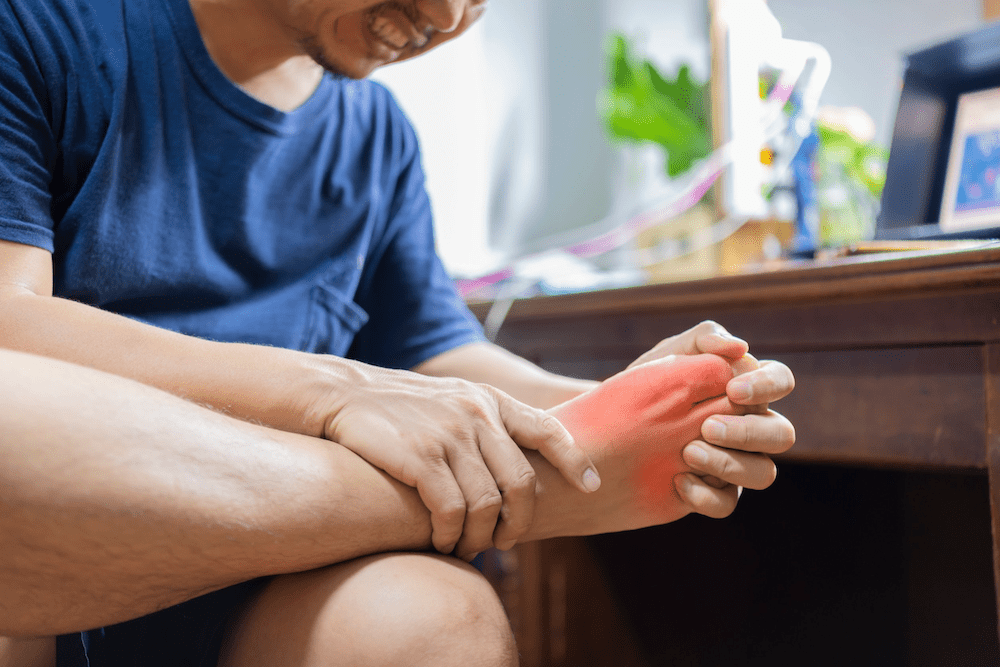Image by 123RF
Gout is a type of arthritis in which the accumulation of uric acid crystals occurs inside your joints. It can affect anyone, characterized by sudden onset of joint pain, along with redness and inflammation. Most commonly, it affects the big toe.
Uric acid occurs as a breakdown product of many foods we eat that contain purine. When your body is unable to handle the load of uric acid, it can result in gout. It, in turn, can lead to complications such as kidney stones, painful arthritis, blockage of kidney tubules with uric acid crystals that can even lead to kidney failure.
Gout pain may occur suddenly at night, and you may wake up from it. The pain may be so severe that you feel like your big toe is on fire, and you can not even bear the weight of the bedsheet.
If you are diagnosed with gout, you should attend follow-up visits with your healthcare provider.
What are the symptoms of Gout?
The symptoms of gout may vary from time to time. Sometimes you may feel better. But when the attack exacerbates, you can not even bear the weight of the bedsheet. The pain due to gout can be intense, and it causes your joints to become red and swollen.
Most commonly, the base of the big toe is the area of a gout attack. However, it can also affect other joints, such as the ankles, wrists, fingers, and elbows.
Gout can be characterized with:
- Intense joint pain that may remain for more than 12 hours
- Lingering discomfort of the joints even after the settlement of acute attack
- Joints become red, swollen, tender, and hot
- Limited range of the motion of joints- as gout keeps progressing, you may not be able to move your joints in the normal range of motion. Prolonged pain can cause the range of motion to deteriorate.
What Causes Gout?
Gout occurs as a result of uric acid buildup in your joints. It happens because when we eat foods that contain purine, it breaks down and eventually produces uric acid as a byproduct.
Under normal conditions, your body can get rid of excess uric acid in the blood through kidneys in the urine. But, if for some reason, the kidneys do not excrete the right amount of uric acid out of your body, leading to deposition in the joints in the form of needles.
What are the risk factors for Gout?
Factors that increase the risk of gout are:
- Being obese
- Being overweight, especially in the youth days
- High blood pressure
- Moderate to heavy alcohol intake
- Diabetes
- Abnormal kidney function
- Metabolic syndrome
- Heart diseases
- Eating a diet rich in sweetened beverages, shellfish, and red meat
Taking certain medications for a long time, such as low dose aspirin, antirejection drugs used in the transplant patient, or other medications used to control high blood pressure. They may include:
- ACE inhibitors such as captopril, enalapril
- Thiazide diuretic such as hydrochlorothiazide
- Beta-blockers such as atenolol, bisoprolol
- Family history of gout
- Gender- males are more prone to develop gout, as compared to females because they have high uric acid levels.
- Undergoing surgery, trauma, or getting vaccinated can trigger a gout attack.
The Bottom Line
Gout occurs due to the high levels of uric acid in your body, which mostly occurs when your kidneys can not filter them well. If you are diagnosed with gout, you must keep an eye on your uric acid levels.
Gout needs to be managed well. Your healthcare providers will prescribe pain relievers and anti-inflammatory drugs to get rid of its symptoms. If you are diagnosed with gout, you must visit the healthcare provider for follow-up visits.
Throughout the year, our writers feature fresh, in-depth, and relevant information for our audience of 40,000+ healthcare leaders and professionals. As a healthcare business publication, we cover and cherish our relationship with the entire health care industry including administrators, nurses, physicians, physical therapists, pharmacists, and more. We cover a broad spectrum from hospitals to medical offices to outpatient services to eye surgery centers to university settings. We focus on rehabilitation, nursing homes, home care, hospice as well as men’s health, women’s heath, and pediatrics.








